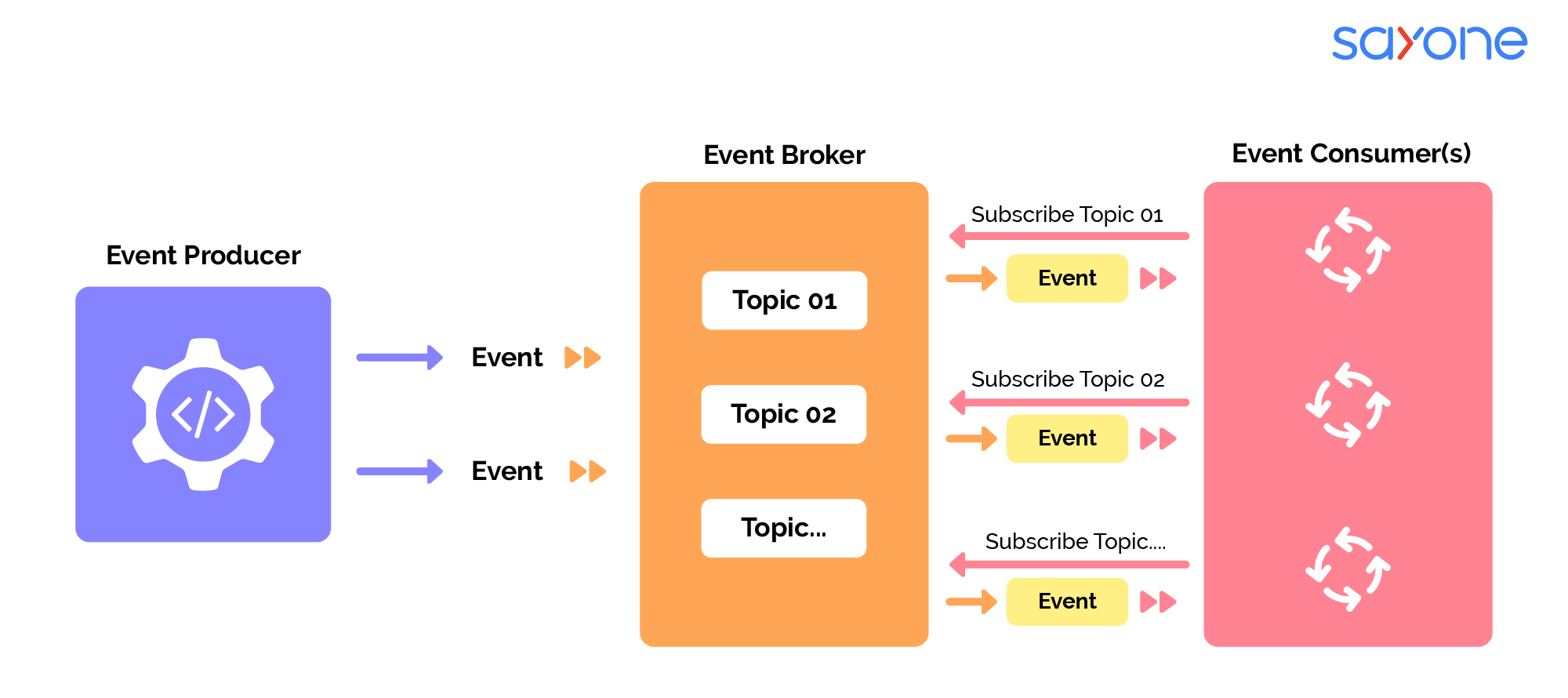Event-Driven Architecture Explained

Share This Article
Table of Contents
Subscribe to Our Blog
We're committed to your privacy. SayOne uses the information you provide to us to contact you about our relevant content, products, and services. check out our privacy policy.
If you’re here, reading this, you have probably heard of and dealt with microservices architecture. And it is great that you have. A survey conducted by IBM recently (in 2021) found out that about 56% of non-users are likely to adopt the microservices approach within the next couple of years.
You might have multiple microservices and you might be looking for a way for them to communicate with each other to form a seamless platform. While you may have used REST, SOAP, or some other way as your service communications layer in the past, event-driven architecture is becoming increasingly popular.
Let's look at the benefits and drawbacks of Event-Driven Architecture Microservices, as well as some of the main design decisions.
What exactly is Event-Driven Microservice Architecture?
When a service performs a particular task that other services might be interested in, that service will produce an event. This event is the record of the action performed. Other services can consume those events, then use them to perform their own execution.

Services that produce requests, unlike REST, do not need to know the details of the services that consume the requests.
For example, an order placed' event is produced when you place an order on an eCommerce platform. This event is then consumed by several other microservices, like:
- The Orders microservice can update the order record to the database
- The Customers microservice can create the order in the customer’s record, and
- The Payments microservice can process the payment for the order.
It is possible to publish events in a variety of methods. They can, for example, be published to a queue that ensures that the event is delivered to the proper consumers, or they can be published to a "pub/sub" model stream that posts the event and lets all interested parties view it.
In either situation, the producer broadcasts the event, which the consumer receives and reacts to. These two actors are sometimes referred to as the publisher (producer) and the subscriber (the consumer).
AWS’ building blocks make building microservices a much easier job. Read our blog titled 'AWS Microservices Architecture' to learn more.
Why Should You Use Event-Driven Architecture?
Loosely Coupled
Services do not require (and should not have) knowledge of or dependency on other services. When services use events, they work independently, with no awareness of other services' technical details or transport protocol. An event model allows services to be upgraded, tested, and deployed separately and with more ease.
Asynchronous
Event-based architectures are non-blocking and asynchronous. This permits resources to go on to the next task without worrying about what happened before or what will happen next once their unit of work is completed. Along with that, they also allow events to be queued or buffered. This prevents consumers from blocking producers.
Highly Scalable
Due to the decoupling of services in an event-driven design, and the fact that services typically execute only one activity, pinpointing bottlenecks and scaling that service becomes extremely simple.
Quick Recovery
By "replaying" events from the past, an event-driven architecture with a queue can recoup lost work. When a consumer needs to recover, this can be useful in preventing data loss.
Event-driven architectures, of course, offer drawbacks as well. They're easy to over-engineer by separating problems that would be simpler if they were near together; they can cost a lot of money upfront; and they frequently result in more complex infrastructure, service schemas, and dependency graphs.
Are you thinking of transitioning your monolithic application into microservices? Talk to us today!
Data and transaction management is perhaps the most major disadvantage. Events are asynchronous. Therefore, it is important that event-driven models handle inconsistent data between incompatible versions, services, and duplicate events carefully. They often do not support ACID transactions, instead opting for eventual consistency, which is more difficult to track and debug.
Despite these disadvantages, for enterprise-level microservice systems, an event-driven design is usually the superior option. The advantages—scalability, loose coupling, and DevOps friendliness—outweigh the disadvantages.
What are the factors you need to keep in mind when picking up a microservices development company?
The Most Crucial Design Decision - Messaging Framework
Now that you have decided on an event-driven architecture, it's time to pick an event framework. The manner in which your events are produced and consumed is a critical component of your system. There are plenty of established frameworks and options available, and selecting the best one takes time and research.
Message processing or stream processing is the most common option.
Message Processing
A component creates a message and transmits it to a defined (and often single) destination. The receiving component, which had been lying idle and waiting for the message, receives it and responds appropriately. On getting a message, the receiving component generally performs an action. The message is then removed. This is Message Processing.
A Message Queue is an example of a message processing architecture. Message (or event) queue designs are still common, even though most modern applications use stream processing which is coming up next.
Download our eBook ‘Choose the best microservices vendor and trim the costs’.
Message queues commonly employ a "store and forward" broker system, in which events are passed from broker to broker until they reach the intended recipient. Message queue technologies like ActiveMQ and RabbitMQ are popular choices. Both of these projects have a long track record of success and well-established communities.
Stream Processing
Components in stream processing, on the other hand, broadcast events when they achieve a given state. Other relevant components monitor the event stream for these events and react appropriately. Events are not targeted at a specific audience but are open to all interested parties.
Components in stream processing can react to many events at once and perform complicated operations on several streams and events. Persistence is a feature of some streams that allows events to stay on the stream for as long as they are required.
Download our eBook for FREE “Global Software Development Rates: An Overview”.
A system can use stream processing to recreate a history of events, come online after an event has happened and yet react to it, and even do sliding window computations. For instance, it may use a stream of per-second events to calculate the average CPU consumption per minute.
Apache Kafka is one of the most used stream processing frameworks. Many projects choose Kafka because it is a mature and robust solution. It can be thought of as a go-to, industrial-grade stream processing solution. Kafka has a big user base, a supportive community, and a well-developed set of tools.
Additional Design Consideration
There are some more challenges to consider once you've chosen your event framework. Combining loosely linked services, different data stores, and atomic transactions is challenging to accomplish. Event Sourcing is a pattern that may be useful here. Updates and deletions are never performed directly on the data in Event Sourcing; instead, state changes of an object are recorded as a series of events. You will also have to decide to deploy your frameworks, on any cloud provider, so that your services run seamlessly.
Is Event-Driven Architecture Suitable For You?
Event-Driven Architecture is suitable when you want to capture both real-world and digital behaviors, as well as relevant facts that may be used to make decisions. Sure, REST and SOAP APIs are simpler to set up, but using them with microservices will make you miss out on the key benefits.
Event-Driven Architecture can completely transform your application, but make sure that you don’t over-engineer it. Too many events will add extra complexity to the services, increase developer cognitive burden, complicate deployment and testing, and cause congestion for event consumers. Every method does not have to be an event.
Looking for web or mobile app development services? Give us a call today.
Also, try to avoid complex dependency graphs. Keep an eye out for services that are interdependent and form complex dependency graphs or feedback loops. Each network hop, especially north/south network traffic leaving the data center, adds latency to the original request.
Final Thoughts
Is all of this too complex and overwhelming? Is it good to replace one type of complexity with another? Yes, if it's handled right and helps you achieve your objectives. Complexity is an engineering problem.
Keep the purpose in mind when developing microservices, whether it's to enable new features, scale-up for more customers, provide a new user experience, or anything else. Don't be shocked if microservices provide their own level of complexity; don't let this deter you.
We hope this blog helped you clear your views about Event-Driven Architecture Microservices, and whether you should use this approach for your application. Just plan well, and follow best practices. That wouldn’t make things easy, but it sure will make things perfect.
How SayOne Can Help
SayOne Technologies extends a helping hand to start-ups, SMBs, and large enterprises to renovate or restructure their legacy information technology systems. We have the expertise and experience to deploy robust, resilient, and independent microservices apps. The API administration platforms developed by us ensure visibility, reliability, security, and adaptability required for the smooth and efficient functioning of microservices. The hallmark of SayOne’s microservices and API solutions include simplified deployment, fast iteration, and significantly reduced time to the market.
The standout features of our services:
- Microservices feasibility analysis
- Custom-built microservices for different industry verticals
- Pre-integrated facilities and infrastructure for microservices
We at SayOne Technologies offer independent services with distinct advantages that enhance business efficiency and foster growth. We start the development process by evaluating your current system to understand your business objectives and then recommend a scalable solution that is best suited for your needs.
In case you are interested in outsourcing microservices applications development, speak to one of our expert developers today!
Share This Article
Subscribe to Our Blog
We're committed to your privacy. SayOne uses the information you provide to us to contact you about our relevant content, products, and services. check out our privacy policy.




